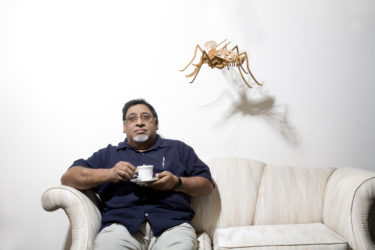By Gerard Best
Gerard Best is a researcher and writer covering social issues across the Caribbean and Latin America. Based in Trinidad and Tobago, he is the former New Media Editor at Guardian Media Limited and the Caribbean Communications Network, the country’s largest media companies. He is the former Communications Specialist for CARCIP, a World Bank-funded technology development 
There may come a time when entomologists don’t have to save us from mosquito-borne pandemics. But that time is not today. Thanks, Zika.
With millions crossing international borders every day, there is more concern than ever about stopping epidemics. Remember chikungunya? When the virus emerged in St Maarten in late 2013, the international mainstream media largely ignored it, although it eventually spread to 45 countries, with more than 1.7 million suspected cases reported to the Pan American Health Organisation.
Fast forward to 2016, and the world is paying close attention to the Zika virus. Once an obscure pathogen, Zika has spread to more than 40 countries in the Americas after an outbreak in northeast Brazil. Transmitted by the same Aedes aegypti and Aedes albopictus mosquitoes that spread chikungunya, Zika is now widely feared for causing birth defects and neurological illness.

All told, Zika could pose an economic burden of $3.5 billion on Latin America and the Caribbean alone, according to a World Bank estimate. And that’s not the half of it. According to the World Health Organization, about 725,000 people are killed every year by mosquito-borne diseases. Malaria alone affects 200 million, of which an estimated 600,000 die. Mosquitoes also spread dengue fever, yellow fever, and encephalitis. At their size, the little blood-suckers are pound for pound one of the deadliest creatures on the planet.
It’s their sheer numbers that make them unstoppable. In peak breeding season, they outnumber every other animal except ants and termites. Public health officials are racing to find new ways to cut the Aedes aegypti mosquito down to size, by making it harder for them to live and breed in and around our homes. But that’s a lot more difficult than it sounds.
Up until his death in June 2016, Dave Chadee, a Professor in Environmental Health at the University of the West Indies, St Augustine, was working with other experts in the Caribbean and around the globe to answer that pivotal question: How to slow down mosquito population growth? Thanks to his findings, researchers now have a clearer understanding of how to keep the number of female adult Aedes mosquitoes below the disease transmission threshold of one per person per household.
To stop a killer, first think like one. After years spent tracking Aedes behavior — how they rest, travel, take blood meals, copulate, and lay eggs — Chadee became fascinated with how the tiny creatures interact with big evolutionary shifts in the natural and manmade environment. Take climate change, for example. He found that as the planet’s temperatures increase, mosquitoes were looking for cooler areas to breed and multiply. His 2016 research study reported that shifts in climate are driving mosquitoes away from artificial containers like plastic bottles, sardine cans, and salmon tins to underground sites like septic tanks and drainage systems.
“This is an adaptation as a result of climate change. The mosquitoes have largely gone underground because of the increase in temperatures on the surface. Previously, it was said that Aedes Aegypti prefer clean clear water and would not go into sewer systems or pit latrines,” Chadee explained in an interview at his office in the Faculty of Science and Agriculture on April 6.
“The use of underground drains and septic tanks represents a major behaviour change and makes it even more difficult to control the Aedes populations.”
Another side effect of warmer climates: Faster reproduction cycles for the mosquitoes. “As temperatures increase, the mosquitoes develop faster. They want to get out of that temperature range as quickly as possible. In fact, there is a threshold of 37°C where mosquitoes die because of the high temperature,” Chadee said.
Don’t underestimate that pesky mosquito. Apart from adapting to climate change, the Aedes is finding new ways to deal with urbanisation. An earlier study by Chadee and others showed a general pattern in the movement of dengue incidents from more rural to urban settings, with hotspot areas associated with transportation hubs.
“We saw a different dynamic coming into play. The mosquitoes are breeding underground and they are taking the blood meal from people waiting for transport at the travel hubs. So they are re-infecting people as they are about to travel, so the people are now the vehicles moving the virus from one place to the other,” he said.
Chadee was working to develop a way to sterilise male mosquitoes, using the same machines used to deliver radiation therapy to cancer patients. The solution would effectively provide birth control and reduce the mosquito population over time.
“This is innovation. Nobody had ever done this before. Everybody wanted to have a nuclear reactor to deliver radiation, to sterilise,” he said. “Our creativity is what has led to the rest of the world now using radiotherapy centres for irradiating mosquitoes.”
Public health officials across the Americas are seeking alternatives to traditional insecticide spraying and other techniques of mosquito control, some of which have been used for decades with no significant impact in slowing transmission. The World Health Organisation is concerned that the same challenge might apply to slowing the spread of Zika.
“Although we’re working to develop the alternatives, we also recognise the need for chemical control, because in an emergency, you need quick action. But we’re trying to develop as many different options as we can for the countries, so that they would be able to decide which strategies are most appropriate for them,” Chadee said.
A further complication to efforts to control the spread of Zika is the uncertainty about which mosquitoes are transmitting the virus. In March, scientists in Brazil indicated that they were able to infect another species, Culex quinquefasciatus, with the virus in a laboratory. Much more work is needed to determine whether Culex mosquitoes can transmit Zika infections.
But the concern is that if Culex were found to transmit Zika infections in large numbers, it could make control efforts a lot more complicated. Controlling the two types of mosquitoes is very different. Aedes aegypti fly no more than 150 yards in their lifetimes and prefer to lay eggs in man-made containers. They require an intense campaign to get rid of breeding spots in homes. Culex mosquitoes can lay eggs in dirty water and are usually treated with spray trucks and planes over larger areas. The two also have very different typical blood feeding times.
A 2013 study by Chadee confirmed that the typical rhythm of the Aedes aegypti’s day involved active blood feeding between 6 to 9 am and between 4 to 6 pm, with typical resting periods from late evening all the way through to early morning. The Culex is a nighttime-active and opportunistic blood feeder.
“The implication is that Zika could be transmitted day and night—Aedes aegypti in the day and Culex in the night. So the spread could be much, much faster and harder to control.” Chadee said.
And for the Caribbean, that’s a job made all the more difficult by the absence of our foremost mosquito expert.





